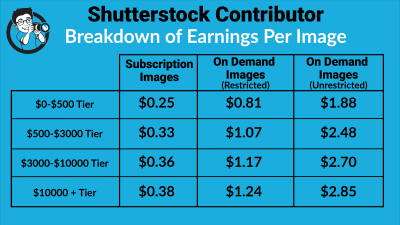If you’ve ever dabbled in photography and wondered how to turn your passion into profit, Shutterstock might just be the perfect platform for you. It’s one of the largest stock photo websites out there, connecting talented photographers with millions of buyers worldwide. Selling your pictures on Shutterstock can be a fantastic way to earn passive income, showcase your work, and even grow your portfolio. Whether you’re a seasoned pro or just starting out, understanding how the process works can make a huge difference. So, let’s dive into what it takes to sell your photos and start earning today!
Understanding Shutterstock’s Contributor Requirements

Before you start uploading your stunning photos, it’s important to understand what Shutterstock looks for in its contributors—and what you need to do to meet their standards. Shutterstock‘s goal is to provide high-quality, relevant images that meet the needs of their global audience. To achieve this, they have some basic requirements that every contributor must satisfy.
1. Technical Quality: Your photos need to be sharp, well-exposed, and properly focused. Blurry, pixelated, or poorly lit images won’t make the cut. Use high-resolution cameras and edit your photos to enhance clarity and color balance.
2. Content Guidelines: Shutterstock prefers original, unique images. Avoid copyrighted material, watermark overlays, or images that include recognizable brands or private property without permission. The content should also be appropriate for commercial use—think landscapes, business scenes, lifestyle, or creative concepts.
3. Model and Property Releases: If your photos feature recognizable people or private property, you’ll need to obtain proper releases. This is crucial for commercial licensing and helps prevent legal issues down the line.
4. File Specifications: Upload images in JPEG format with a minimum of 4 megapixels (generally at least 3900 pixels on the longer side). The files should be clean, without watermarks or borders, and saved in sRGB color profile for best color accuracy.
5. Submission Process: Create a contributor account on Shutterstock, review their contributor guidelines thoroughly, and start uploading. They review each submission to ensure it meets their standards before approving it for sale.
Remember, Shutterstock values consistency and quality. Taking the time to produce high-quality images that meet their criteria will increase your chances of approval and, ultimately, your earning potential. So, invest in your skills, familiarize yourself with their policies, and get ready to share your work with the world!
Creating High-Quality Photos That Appeal to Buyers

When it comes to selling your pictures on Shutterstock, the first step is making sure your photos are truly compelling and high quality. Think of your images as a storefront—if they look appealing and professional, more people will want to browse and buy. So, how do you create photos that stand out?
First, focus on technical excellence. This means sharp focus, proper exposure, and good lighting. Blurry, dark, or overexposed photos tend to get ignored. Use a good camera or even a smartphone with a high-quality camera, but always pay attention to the basics—like steady shots and correct settings.
Next, consider composition. Use the rule of thirds—imagine splitting your frame into nine equal parts and placing key elements along these lines or intersections. This creates a balanced and engaging image. Also, keep your backgrounds clean and uncluttered so the main subject pops.
Subjects matter too. Think about what buyers are searching for—business themes, travel, nature, lifestyle, food, technology, etc. Keep your images relevant to popular categories. Adding diversity to your portfolio helps attract a broader audience.
Another tip is to focus on originality and storytelling. Instead of generic shots, try to capture genuine moments or unique perspectives that tell a story. Buyers love images that evoke emotion or connect with a particular theme or idea.
Lastly, stay updated on current trends. Check out Shutterstock’s trending images and categories. Incorporate elements that are in demand, but always stay true to your style and creativity. Remember, quality over quantity is key—upload fewer, excellent images rather than many mediocre ones.
Preparing Your Images for Submission
Once your high-quality photos are ready, the next step is preparing them for submission to Shutterstock. Proper preparation ensures your images meet the platform’s standards and increases your chances of acceptance and sales.
First, review Shutterstock’s image requirements. They specify technical specs like resolution, file format, color profile, and more. Typically, they want images in JPEG format with a minimum of 4 megapixels, sRGB color space, and a resolution of at least 300 dpi.
Before uploading, do a thorough edit of your images. Use photo editing software like Adobe Lightroom or Photoshop to enhance colors, adjust brightness and contrast, and crop to improve composition. Avoid over-editing—aim for natural, true-to-life images.
Make sure to:
- Rename your files with descriptive, keyword-rich filenames. Instead of “IMG_1234.jpg,” use “sunset-beach-hawaii.jpg” to help buyers find your images.
- Add relevant keywords and descriptions. Shutterstock relies heavily on metadata to categorize and display your images. Use accurate, varied keywords that describe your photo’s content, mood, and use cases.
- Set appropriate licenses. Shutterstock offers Standard and Extended licenses. For most photographers, Standard is enough, but familiarize yourself with the differences so you can choose appropriately.
- Ensure your images are free of watermarks, logos, or any branding. Only submit your original photos without any embedded watermarks.
Finally, double-check every image for consistent quality and adherence to Shutterstock’s guidelines. Upload your images in batches, and consider organizing them into folders with relevant keywords to streamline your workflow. Taking time to prepare your images thoroughly can make a big difference in how quickly they get accepted and how well they perform once live.
Uploading Your Photos and Optimizing Metadata
Once you’ve curated a collection of high-quality photos ready to share, the next step is uploading them to Shutterstock. But it’s not just about clicking the upload button and hoping for the best. To truly maximize your earning potential, you need to pay attention to how you present your images—especially through optimizing metadata.
When you upload your photos, Shutterstock will prompt you to add details such as titles, descriptions, keywords, and categories. Think of this as giving your images a compelling “story” that helps buyers find them easily. The better you craft these details, the more likely your photos are to appear in relevant searches.
Tips for Effective Uploads and Metadata Optimization:
- Use Clear, Descriptive Titles: Make your titles straightforward and accurate, highlighting what makes your photo unique. Instead of “Beautiful Landscape,” try “Sunset Over Mountain Range with Pink Sky.”
- Write Detailed Descriptions: Expand on your title by describing the scene, mood, and any notable elements. This adds context and helps search engines understand your image better.
- Choose Relevant Keywords: Think like your potential buyers. What words would they type to find your shot? Use a mix of broad and specific keywords—like “nature,” “mountains,” “sunset,” “dusk,” or “hiking.”
- Categories Are Key: Assign your photo to the most fitting categories to increase its visibility in relevant browsing sections.
Remember, avoid keyword stuffing or using irrelevant tags—this can hurt your ranking and may violate Shutterstock’s policies. Instead, focus on accuracy and usefulness. Also, ensure your images are properly titled and described before submitting, as this process can influence your photo’s discoverability over time.
Quality Checks Before Upload
Before hitting upload, double-check your images for technical issues: no watermarks, appropriate resolution (at least 4MP), and proper color profiles (sRGB is recommended). Clear, sharp, and well-exposed photos are more likely to sell.
Finally, keep organized records of your uploads and metadata. As you upload more images, it gets easier to manage and refine your approach based on what’s performing well. Remember: good metadata is your best friend in getting your pictures seen and purchased.
Strategies to Increase Your Photo Sales on Shutterstock
So, you’ve uploaded your images and optimized their metadata. Great! But how do you actually boost your sales and make steady income from your photos? Let’s explore some practical strategies that can help you stand out and sell more on Shutterstock.
1. Consistently Upload New Content
The more fresh, relevant images you add, the higher your chances of appearing in searches. Regular uploads show Shutterstock that you’re an active contributor, which can boost your visibility. Plus, staying current with trending topics or seasonal themes can attract more buyers.
2. Focus on Niche Markets
While broad themes are good, niche markets often face less competition. Think about specialized subjects you’re passionate about—like specific hobbies, cultural themes, or unique locations. Niche images can become go-to resources for particular buyer needs.
3. Study Best Sellers and Trends
Spend some time browsing Shutterstock’s top-selling images and trending categories. Notice what styles, subjects, and colors are popular. Incorporate these insights into your own shoots to increase the likelihood of sales.
4. Promote Your Portfolio
Don’t rely solely on Shutterstock’s internal search. Share your portfolio on social media, photography forums, or personal websites. Building your own audience can lead to direct sales or referrals back to your Shutterstock profile.
5. Offer Variety and Flexibility
- Multiple Formats: Upload images in different orientations, crops, or color variations when possible.
- Exclusive Content: Consider offering exclusive images for premium prices, if your account type allows.
- Different Price Points: Ensure your portfolio includes both high-end, detailed shots and more generic images to appeal to a wider range of buyers.
6. Keep Improving Your Skills and Portfolio
Stay updated with photography techniques, editing skills, and composition. The better your images look, the more they’ll sell. Experiment with different styles, lighting, and subjects to diversify your portfolio.
7. Monitor Your Performance and Adjust
Use Shutterstock’s analytics tools to see which images are performing well and which aren’t. Pay attention to which keywords and categories drive sales. Use this data to refine your future uploads and metadata strategies.
By applying these strategies consistently, you can build a robust portfolio that not only attracts more buyers but also generates a steady stream of income. Remember, patience and persistence are key—success on Shutterstock often comes with time and continuous effort.
Tips for Maintaining a Consistent Portfolio
Building a successful stock photography portfolio isn’t just about uploading random images — it’s about creating a cohesive collection that tells a story and appeals to your target audience. Consistency in your portfolio can really set you apart and make it easier for buyers to find what they need. Here are some friendly tips to help you keep your portfolio fresh, focused, and engaging:
- Define Your Niche: Think about what kind of photos you’re passionate about and what sells well. Whether it’s nature, lifestyle, technology, or food, sticking to a niche helps you become known for a specific style or subject matter.
- Establish a Style or Theme: Consistency in lighting, color palette, or composition can create a recognizable brand for your work. For example, do you prefer bright and vibrant images, or moody and muted tones? Keeping a signature style makes your portfolio more memorable.
- Plan Your Content: Before shooting, plan a shot list aligned with your niche and style. This prevents random uploads and keeps your portfolio focused on what you want to showcase.
- Regularly Update Your Portfolio: Keep adding new images regularly to show you’re active and evolving. Fresh content can boost your visibility and keep your portfolio interesting for repeat visitors.
- Organize Your Files: Use clear naming conventions and categorize your images. This makes it easier for you to manage your portfolio and for clients to find what they’re looking for.
- Quality Over Quantity: Focus on uploading high-quality, well-composed images. A polished portfolio with fewer, standout images often performs better than one cluttered with mediocre shots.
Remember, maintaining a consistent portfolio is an ongoing process. It’s about showcasing your best work in a way that aligns with your personal style and market demands. Over time, this consistency helps build your reputation and attracts loyal buyers.
Monitoring Your Earnings and Improving Your Sales Performance
Once you start uploading and selling your pictures, it’s essential to keep an eye on your earnings and analyze your sales performance. Understanding what works and what doesn’t allows you to make smarter decisions and boost your profits. Here’s how you can stay on top of your Shutterstock journey:
- Regularly Check Your Dashboard: Log into your Shutterstock contributor account often to see your sales data. Pay attention to which images are selling well and which aren’t.
- Analyze Your Best Sellers: Identify patterns in your top-performing images. Are they in a specific niche? Do they follow certain color schemes or themes? Use this insight to guide your future uploads.
- Track Your Earnings: Keep a record of your monthly income. This helps you understand your earning trends and set realistic goals for growth.
- Experiment and Adapt: If certain types of images aren’t selling, consider shifting your focus. Try new styles, themes, or subjects based on market demand and your audience’s preferences.
- Optimize Your Keywords and Titles: Well-crafted keywords and descriptive titles improve your images’ discoverability. Review your existing images and refine their metadata to boost visibility.
- Stay Updated on Market Trends: Follow industry blogs, forums, and Shutterstock’s updates to learn about trending topics and popular styles. Incorporate these insights into your work.
- Set Goals and Review Progress: Whether it’s increasing monthly sales or diversifying your portfolio, setting clear targets helps you stay motivated and focused. Regularly review your progress and adjust your strategies accordingly.
Remember, improving your sales performance is a continuous journey. The more you analyze and adapt, the better you’ll become at creating images that sell. Keep experimenting, stay informed, and celebrate your successes along the way!
Legal Considerations and Copyright Guidelines for Shutterstock Contributors
Before you start uploading your beautiful images to Shutterstock, it’s super important to understand the legal stuff—because nobody wants to deal with copyright issues or legal headaches down the line. Shutterstock has clear guidelines to help you stay on the right side of the law and protect your work, as well as the rights of others.
First off, your images must be your original work. That means you took the photo yourself and you have the rights to upload and sell it. If you’re using stock photos, graphics, or any other assets that aren’t yours, you need to have proper licensing or permissions. Otherwise, you risk having your content rejected or, worse, facing legal action.
Another big point is model and property releases. If your photo features recognizable people or private property, you’ll need to get a signed release form from the individual or the property owner. Shutterstock is pretty strict about this, and images without releases of recognizable people or private property may be rejected or removed.
Here’s a quick checklist to keep your legal game strong:
- Only upload images you’ve created or have rights to.
- Obtain model releases for identifiable people.
- Get property releases for private or recognizable private property.
- Avoid copyrighted elements like logos, trademarks, or branded products.
- Ensure all your metadata is accurate and truthful.
Remember, Shutterstock does have a review process, and they might reject images that don’t comply with their guidelines. So, it’s worth double-checking your submissions before uploading. Also, keep in mind that copyright laws can vary by country, so if you’re unsure about a particular image or element, consult a legal expert or do some research to stay safe.
By respecting copyright guidelines and understanding the legal landscape, you not only protect yourself but also build a reputable portfolio that buyers can trust. It’s all about creating a win-win situation—your art stays safe, and your sales can grow without legal worries hanging over your head.
Conclusion and Next Steps to Maximize Your Photography Profits
Congratulations! You now have a solid understanding of how to sell your pictures on Shutterstock and turn your passion into profit. The journey doesn’t end here, though. To really maximize your earnings and build a thriving photography side hustle, you’ll want to keep evolving your approach.
Here are some next steps to help you boost your photo sales:
- Consistently upload high-quality, diverse images. The more variety you offer, the higher your chances of catching a buyer’s eye.
- Research trending topics and popular categories. Stay updated on what’s in demand—whether it’s business, lifestyle, or nature photography—and tailor your shoots accordingly.
- Optimize your keywords and descriptions. Use relevant, descriptive keywords to make sure your images are easily discoverable in search results.
- Engage with the community. Join Shutterstock contributor forums or social media groups to learn tips, share experiences, and stay motivated.
- Track your performance. Use Shutterstock’s analytics to see which images sell best and focus on creating similar content.
- Expand your portfolio. Consider branching out into new styles or niches to reach different audiences.
Remember, patience and persistence are key. Building a successful stock photography business takes time, but each upload brings you closer to a steady stream of passive income. Keep honing your skills, stay legal and ethical, and don’t be afraid to experiment with new ideas.
So, grab your camera, keep creating, and let the world see your unique perspective. With dedication and smart strategies, you’ll turn your passion for photography into a profitable venture on Shutterstock!


